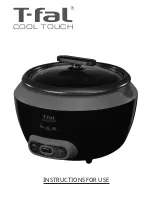
TECH SHEET - DO NOT DISCARD
PAGE 9
FOR SERVICE TECHNICIAN’S USE ONLY
PART NO. W10054150
EXHAUST TEMPERATURES
TEMPERATURE
SETTING
HEAT TURNS OFF*
°F
(°C)
HEAT TURNS ON
°F
(°C)
High
155°±5° (68°±3°)
10°–15° (6°–8°)
below the
heat turn off
temperature
Medium
140°±5° (60°±3°)
Low
125°±5° (52°±3°)
Extra Low
105°±5° (41°±3°)
*
The measured overshoot using the glass
bulb thermometer in the exhaust outlet can
be 30°F (17°C) higher.
5.
If the exhaust temperature is not within
specified limits, or you have come here
from step 3, remove the P4 connector,
then measure the resistance between
P4-3 (red wire) and P4-6 (red wire) at the
connector. See figure 15, page 11 for
connector location; and Accessing &
Removing the Electronic Assemblies,
page 11.
➔
If the resistance is OK, check P4-3 and
P4-6 to machine ground.
➔
If resistance is greater than 0 (zero),
replace wiring harness.
NOTE:
All thermistor resistance
measurements must be made while dryer
is disconnected from power.
The following table gives temperatures
and ranges for the associated thermistor
resistance values.
EXHAUST THERMISTOR RESISTANCE
TEMP.
°F
(°C)
RES.
k
Ω
TEMP.
°F
(°C)
RES.
k
Ω
50° (10°)
19.0–22.0
80° (27°)
8.5–10.5
60° (16°)
14.8–16.8
90° (32°)
6.8–8.8
70° (21°)
11.5–13.5
100° (38°)
5.0–7.0
➔
If the thermistor resistance does not
agree with table, replace the exhaust
thermistor.
➔
If the thermistor resistance checks
agree with the measurements in the
table, replace the machine control
electronics.
INLET THERMISTOR
The machine control electronics monitors the
inlet temperature using an inlet thermistor
that is part of the high limit thermostat
assembly.
1.
Activate the diagnostic test mode. See
procedure on page 1.
2.
If
F-24
or
F-25
is a displayed error in the
diagnostic test mode, the thermistor or
wire harness is either open or shorted.
➔
Unplug dryer or disconnect power.
➔
Check wire connections at the
machine control electronics and inlet
thermistor. See Accessing & Removing
the Electronics Assemblies, page 11,
and for inlet thermistor location see
figure 9, page 8.
➔
If wire connections are good, remove
the wires from the inlet thermistor/high
limit thermostat assembly and replace
the assembly.
➔
Plug in dryer or reconnect power.
3.
If
F-24
or
F-25
is not an error that is dis-
played in the diagnostic test mode, the
connections to the thermistor are good.
Therefore, check the thermistor’s resis-
tance value, using the following process:
➔
Unplug dryer or disconnect power.
➔
Access the heater assembly. See
figure 2, page 6; and Removing the
Back Panel, page 12.
➔
Hold a glass bulb thermometer
capable of reading from 68° to 176°F
(20° to 80°C) in the heater assembly.
➔
Check the resistance of the inlet
thermistor. See figure 9, page 8 for
location.
INLET THERMISTOR RESISTANCE
TEMP.
°F
(°C)
RES.
RANGE
k
Ω
TEMP.
°F
(°C)
RES.
RANGE
k
Ω
68° (20°) 61.2–63.7 131° (55°) 14.6–15.3
77° (25°) 49.0–51.0 140° (60°) 12.1–12.8
86° (30°) 39.5–41.1 149° (65°) 10.2–10.7
95° (35°) 32.0–33.3 158° (70°)
8.5–9.0
104° (40°) 26.1–27.2 167° (75°)
7.2–7.6
113° (45°) 21.4–22.3 176° (80°)
6.1–6.5
122° (50°) 17.6–18.5
The table above shows the resistance
values that should be observed for the
various temperatures at the heater
assembly.
➔
If the thermistor resistance does not
agree with the measurements in the
table, replace the inlet thermistor/ high
limit thermostat assembly.
➔
If the thermistor resistance agrees with
the measurements in the table, replace
the machine control electronics.
TEST #4b
Thermal Fuse
The thermal fuse is wired in series with the
dryer drive motor.
1.
Unplug dryer or disconnect power.
2.
Access the thermal fuse by first removing
the back panel. See Removing the Back
Panel, page 12; and for thermal fuse
location see figure 9, page 8.
3.
Using an ohmmeter, check the continuity
across the thermal fuse.
➔
If the ohmmeter indicates an open
circuit, replace the failed thermal fuse.
TEST #4c
Thermal Cut-Off
If the dryer does not produce heat, check the
status of the thermal cut-off.
1.
Unplug dryer or disconnect power.
2.
Access the thermal cut-off by first
removing the back panel. See Removing
the Back Panel, page 12.
3.
Using an ohmmeter, check the continuity
across the thermal cut-off. See figure 9,
page 8, for location.
➔
If the ohmmeter indicates an open
circuit, replace the failed thermal
cut-off and inlet thermistor/high limit
thermostat. In addition, check for
blocked or improper exhaust system,
or failed heat element.
TEST #5
Moisture Sensor
NOTE:
This test is started with the machine
completely assembled.
This test is performed when an automatic
cycle stops too soon, or runs much longer
than expected.
NOTE:
Dryer will shut down automatically
after 2½ hours.
The following items are part of this system:
–
Harness/connection
–
Metal sensor strips
–
Machine control electronics
1.
Activate the diagnostic test mode and
advance past saved fault codes. See
procedure on page 1.
2.
Open the dryer door. If a continuous
beep tone is heard and an alphanumeric
number is displayed on the console as
soon as the door is opened, a short
circuit exists in the moisture sensor
system.
➔
If this doesn’t happen, go to step 3.
➔
Otherwise, go to step 4.
NOTE:
Over drying may be caused by a
short circuit in the sensor system.
3.
Locate the two metal sensor strips on the
inside of the dryer. Bridge these strips
with a wet cloth or finger.
➔
If a continuous beep tone is heard and
a software revision number is
displayed on the console, the sensor
passes the test. Go to step 8.
➔
If not, continue with step 4.
4.
Access the moisture sensor wires:
➔
Remove the back panel. See
Removing the Back Panel, page 12.
➔
Remove the lint screen.
➔
Remove the two screws holding the lint
screen duct to the top.
➔
Remove four screws from bottom of
the duct in rear. See figure 9, page 8.
➔
Remove the duct from the dryer to
access the moisture sensor.






























